
Original Link: https://www.anandtech.com/show/1986
Intel Pentium D 805 - Dual Core on a Budget
by Anand Lal Shimpi on April 7, 2006 12:00 AM EST- Posted in
- CPUs
When Intel introduced its first line of dual core desktop processors we were all shocked at how cheap you could buy them. The Pentium D 820, running at 2.8GHz, was the first Intel processor we recommended since Intel's Northwood core. It was no surprise to anyone that Prescott was too hot and offered no real performance advantage to justify its downside when compared to AMD's Athlon 64 CPUs. With the Pentium D, Intel still had the heat problems and underwhelming performance, but for heavy multitaskers and users of multithreaded applications the performance could not be beat. The Pentium D 820 debuted at $241, putting it at about the same price as a single core Athlon 64 3500+.
AMD eventually responded by introducing an Athlon 64 X2 3800+, priced at $354. While it was still more expensive than Intel's entry level dual core, it was a step in the right direction for AMD and the X2 3800+ quickly became a favorite among enthusiasts. The X2 3800+ managed to outperform, in many cases, Intel's most expensive dual core processors while running a lot cooler and being offered at a much better price point.
Intel's ability to undercut AMD's pricing on dual core processors is not too difficult to understand. Until recently, AMD has only had a single plant producing 90nm processors on 200mm wafers, meaning that every dual core CPU they produce made a serious dent in the number of total CPUs they can produce. Even though AMD's new Fab 36 just started shipping revenue generating product, dual core chips will continue to come out of Fab 30 for the time being. Intel, by comparison, has a total of five 300mm fabs currently in production that crank out both 90nm and 65nm CPUs. Being able to produce chips on 300mm wafers itself means that you can make more chips at a time, but also having many more fabs helps as well. Intel estimates that its five 300mm fabs can produce as many chips as approximately eight of its older 200mm fabs. What this all boils down to is that pricing its entry-level dual core processor in the $200 - $250 range is not too difficult for Intel, but with the introduction of the Pentium D 900 series the deal was about to get even sweeter.
With the Pentium D 900 series, Intel took its dual core processors and started making them on a 65nm process. Along with the die shrink Intel equipped their 65nm offerings with twice the L2 cache as their 90nm 800 series, thus making them even more desirable. The icing on the cake was that the Pentium D 900 series was not much more expensive than the 800 series it was replacing; the Pentium D 920 can be found today for as low as $244.
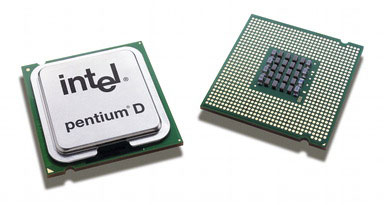
With Intel intent on moving all of its processors over to 65nm, the older 90nm Pentium D line got a nice price cut. The once $240+ Pentium D 820 is now a $160 chip, making it around the price of a single core Athlon 64 3200+. Although the single core AMD CPU will still do better in gaming, the Pentium D 820 will definitely hold its own in any multithreaded environments or encoding tasks. To even further move the market to dual core, Intel quietly introduced yet another processor - the 90nm Pentium D 805. Clocked at 2.66GHz with a meager 533MHz FSB (compared to 800MHz of the other Pentium D CPUs), the Pentium D 805 can be had for as little as $132.
Sit back and think about that for a moment; for $133 you are getting a dual core processor that can run in any LGA-775 Intel 945 based motherboard. It wasn't very long ago that a SMP system would cost you significantly more than a high end desktop setup, but thanks to the move to dual core CPUs and some very aggressive pricing on Intel's part, you can now have a dual core processor for about $20 more than a Celeron.
Admittedly we've been a bit too high end focused lately here on AnandTech, as seemingly all that's been released these days is Extreme Edition this and FX that. But if you have to upgrade today, now is truly a great time to buy something low end as you await the next-generation of CPUs and platforms from AMD and Intel.
The Contenders
We chose a wide variety of CPUs to include in this comparison mostly based on price, after all we are interested primarily in value here. The list of CPUs and our reasoning behind including them follows below:
Intel Pentium D 920 (2.8GHz, dual core, 2MB L2 per core), Current Price: $244
The Pentium D 920 is the most expensive Intel CPU we've got in this comparison, and its role here is simply as a reference point. It is a cooler running 65nm chip, but it is priced around $100 more than its Pentium D 820 predecessor.
Intel Pentium D 820 (2.8GHz, dual core, 1MB L2 per core), Current Price: $160
You simply can't do a value dual core comparison without including the Pentium D 820. It was the first value dual core processor and to this day continues to be a great value. Other than its higher clock speed, the Pentium D 820 offers an 800MHz FSB which should come in handy in bandwidth intensive multithreaded applications.
Intel Pentium D 805 (2.66GHz, dual core, 1MB L2 per core), Current Price: $133
And of course the reason we're all here today is the Pentium D 805; $27 cheaper than the Pentium D 820, we're simply interested in finding out whether the slower 533MHz FSB and lower clock speed translate into significantly worse performance than its more expensive brother.
Intel Pentium 4 631 (3.0GHz, single core, 2MB L2), Current Price: $185
If you're intent on going Intel but want the fastest single core they offer at the same price as the Pentium D 805, the Pentium 4 631 is what you'll end up with. We included the 631 to answer the age-old (read: 2 years old) question: do you go with one fast core or two slower cores?
Intel Celeron D 351 (3.2GHz, single core, 256KB L2), Current Price: $110
We haven't looked at the Celeron D in a while, but at 3.2GHz it could be a fairly decent contender. In Intel's usual style, the Celeron D is crippled by having no Hyper-Threading support, a 533MHz FSB and only 256KB of L2 cache.
AMD Athlon 64 X2 3800+ (2.0GHz, dual core, 512KB L2 per core), Current Price: $295
AMD's entry-level dual core is the Athlon 64 X2 3800+. While its $295 entry fee is significantly more than the Pentium D 805, it's still worth including because it is such a formidable opponent. But for those interested in the absolute lowest cost, just like the Pentium D 920, it's here mostly as a reference point.
AMD Opteron 165 (1.8GHz, dual core, 1MB L2 per core), Current Price: $316
The Opteron 100 series are all Socket-939 parts, meaning they will work on desktop 939 motherboards with the latest BIOS. The 165 is particularly interesting because it is clocked slightly lower than the entry level desktop dual core part. However, being equipped with a 1MB cache per core means that the cost to manufacture isn't actually lower than the X2 3800+. We included it here, once again, mostly as a reference point as we've never done a formal Opteron 165 vs. X2 3800+ comparison.
AMD Opteron 144 (1.8GHz, single core, 1MB L2), Current Price: $177
Another Socket-939 Opteron, the 144 is simply a single core version of the dual core 165. It is the cheapest Socket-939 CPU you can get with a 1MB L2 cache, offering performance somewhere in-between the Athlon 64 3000+ and the 3200+.
AMD Athlon 64 3000+ (1.8GHz, single core, 512KB L2), Current Price: $120
Finally we have AMD's cost-competitor to the Pentium D 805, it's the single core Socket-939 Athlon 64 3000+. You get the lowest clocked Socket-939 Athlon 64, with a small 512KB L2 and only a single core. But what a fierce core it is; can it stand up to two of Intel's not-so-greatest cores in the Pentium D 805? Let's find out.
The Test
We've described all of our tests and what they do in previous articles; click back over to any of them if you want more detail on what's going on with each one of the tests.
| CPU: | AMD Athlon 64 X2 3800+ (2.0GHz/512KBx2) AMD Athlon 64 3000+ (1.8GHz/512KB) AMD Opteron 165 (1.8GHz/1MBx2) AMD Opteron 144 (1.8GHz/1MB) Intel Pentium D 920 (2.8GHz/2MBx2) Intel Pentium D 820 (2.8GHz/1MBx2) Intel Pentium D 805 (2.66GHz/1MBx2) Intel Pentium 4 631 (3.0GHz/2MB) Intel Celeron D 351 (3.2GHz/256KB) |
| Motherboard: | ASUS A8N-SLI Deluxe ASUS P5LD2 Deluxe |
| Chipset: | NVIDIA nForce4 SLI Intel 945P |
| Chipset Drivers: | nForce4 6.70 Intel 7.2.2.1006 |
| Hard Disk: | Seagate 7200.9 300GB SATA |
| Memory: | OCZ PC3500 DDR 2-2-2-7 DDR2-667 4-4-4-15 |
| Video Card: | NVIDIA GeForce 7800 GTX |
| Video Drivers: | NVIDIA ForceWare 84.21 |
| Desktop Resolution: | 1280 x 1024 - 32-bit @ 60Hz |
| OS: | Windows XP Professional SP2 |
Overall Performance using Winstone 2004
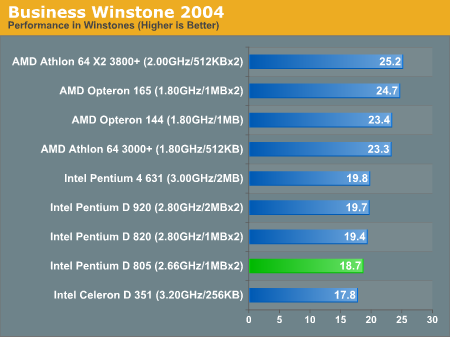
Business Winstone and business applications in general have hardly been a strong point of Intel's NetBurst architecture. The Pentium D 805, along with its brethren, fall to the bottom of the chart. The 805 actually only loses about 4% of the performance of the Pentium D 820, but if single task office applications are all you'll be using you are much better off with the single core Athlon 64 3000+. Even with light multitasking thrown in (as the Business Winstone suite tests), you're still better off with the Athlon 64. You will however lose some of the increase in responsiveness that a dual core CPU will afford you, as dual core CPUs can help mask much of the impact of poor scheduling by Windows when multitasking.
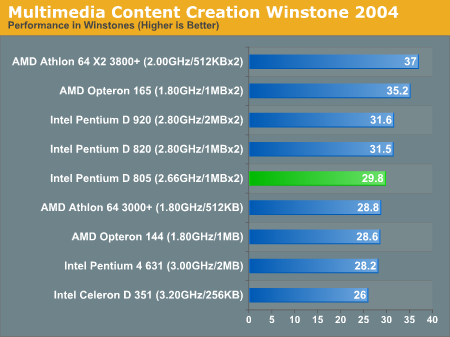
The picture changes a bit when you toss some 3D rendering and more multimedia centric applications into the mix. Now the Pentium D 805 offers better performance than the Athlon 64 3000+, while giving you the more tangible but not easily quantifiable benefits of a dual core CPU.
As the tasks become more intense, the higher clock and faster FSB of the Pentium D 820 become more important; here the Pentium D 820 holds close to a 6% advantage over the 805. Of course at the top of the charts are the Opteron 165 and Athlon 64 X2 3800+, but at more than twice the price of the Pentium D 805 you would expect no less.
Overall Performance using SYSMark 2004
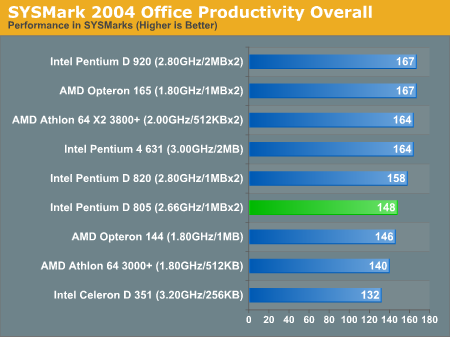
In the Office Productivity suite of SYSMark 2004 you see a similar picture of the AMD/Intel rivalry to what we saw in MMCC Winstone, with the Pentium D 805 offering performance slightly faster than that of the single core Athlon 64 3000+ and Opteron 144. The Pentium D 820 really starts to show its worth here, offering an almost 7% performance advantage over the 805.
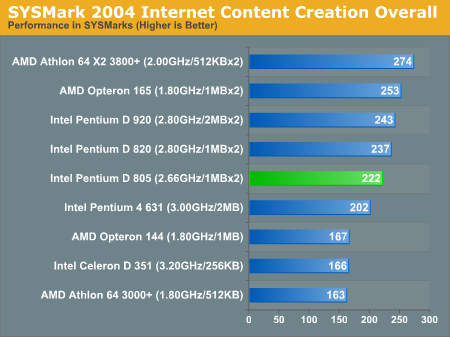
SYSMark's Internet Content Creation tests are dominated by the Athlon 64 X2 3800+, but the Pentium D 805 also does exceptionally well for its price. Here we see about a 36% increase in performance over the similarly priced Athlon 64 3000+. A major reason for the performance improvement due to dual core/Hyper-Threading in this test is because ICC SYSMark 2004 will actually trigger one of those dreaded appllication stalls when multitasking and switching between two applications. Having a Hyper-Threading enabled or dual core CPU alleviates the problem and lets things move a lot smoother. There are obviously other performance benefits to dual core, but SYSMark actually offers us a way of measuring what is normally a very unquantifiable benefit of dual core CPUs.

The overall picture in SYSMark is pretty good for the Pentium D 805: it shows the processor offering greater performance than its AMD cost-competitor, and about 93% of the performance of the Pentium D 820. Interestingly enough, SYSMark on average shows the Pentium D 805 basically equalling the performance of the single core Pentium 4 631.
Overall Performance using PC WorldBench 5
WorldBench is predominantly a single-threaded benchmark that tests mostly older versions of commonly used software. As such, it ends up being a very real world test of how many still use their PCs today.
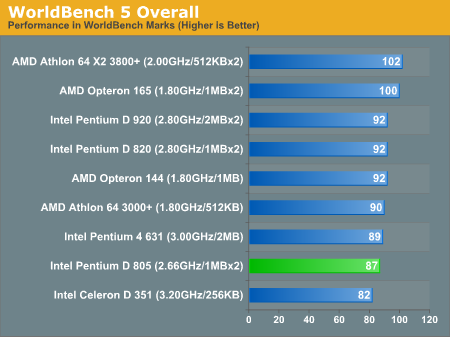
With the vast majority of tests being single threaded, the Pentium D 805 can't catch a break, although on average it finds itself within about 3% of the Athlon 64 3000+. While it's still noticeably slower than the Athlon 64 X2 3800+, the performance isn't terrible for its price.
3D Rendering Performance using 3dsmax 7
Ever since we first laid hands on a dual core processor one thing became very clear: heavy multitasking or multithreading guaranteed a performance victory over a single core CPU. That truth is once again made evident here in our 3dsmax test, where none of the single core CPUs can even come close to the performance of the slowest dual core CPU we've got on hand. The Pentium D 805 offers very competitive performance, much higher than any of its single core competitors and not too far off from the majority of its dual core counterparts.

The 805 is within about 6% of the Pentium D 820 and 920, although the X2 3800+ manages to outperform it by 20%.
Media Encoding Performance using WME, DivX, Quicktime and iTunes
All of our media encoding tests are multithreaded, as most media encoding tasks are, and thus the dual core CPUs do very well.
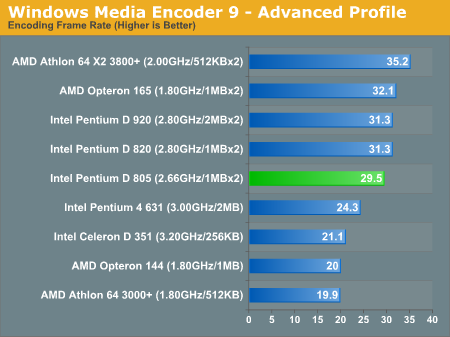
Under Windows Media Encoder, the Pentium D 805 is extremely competitive. The top spot is of course reserved for the Athlon 64 X2 3800+, but at 29.5 fps the Pentium D 805 is noticeably faster than anything else in its price class.
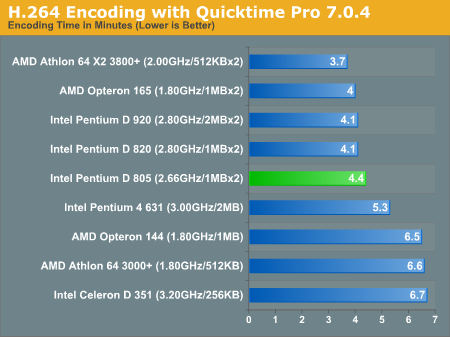
The picture is really no different under Quicktime 7.0.4 with H.264 encoding: the Pentium D 805 is truly a bargain, offering good middle of the road performance at a low end price.
And the trend continues with DivX 6.1.1 and iTunes:
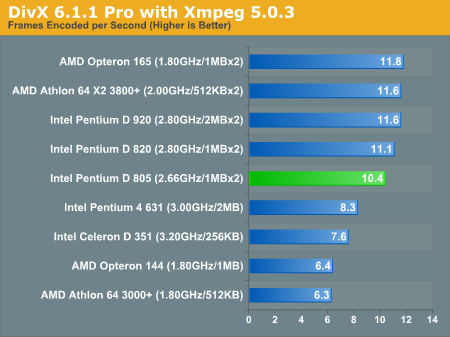
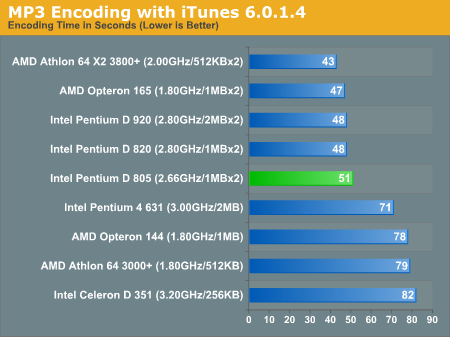
Gaming Performance using F.E.A.R. and Quake 4
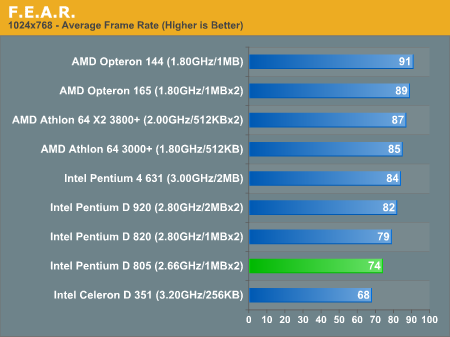
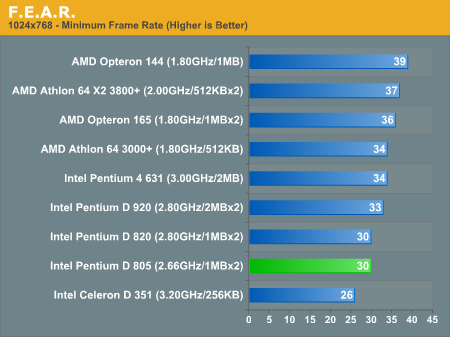
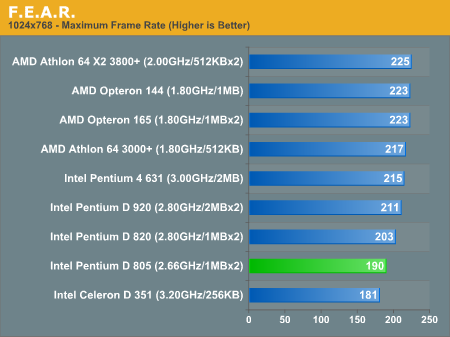
F.E.A.R. shows the Pentium D 805 and the rest of the Intel crowd falling to the bottom of the chart. The Athlon 64 3000+ enjoys its largest margin of victory here, offering a 15% advantage over the Pentium D 805.

We included Quake 4 with its new 1.1 patch because the patch enables SMP support; SMP was enabled on both Hyper-Threading and dual core CPUs, which is why you see them outperforming their single-core counterparts. If more games took advantage of SMP in the same manner as Quake 4, the Pentium D 805 would be a fairly strong gaming CPU. In reality, there are only two current PC games offering SMP support: Quake 4 and Call of Duty 2, and the former benefits much more than the latter.
Power Consumption
As always, we measured power consumption of the entire system at the wall outlet. First up is power consumption with the test system at idle. Here AMD's Cool 'n Quiet and Intel's EIST really come into play and do their best to reduce power consumption:
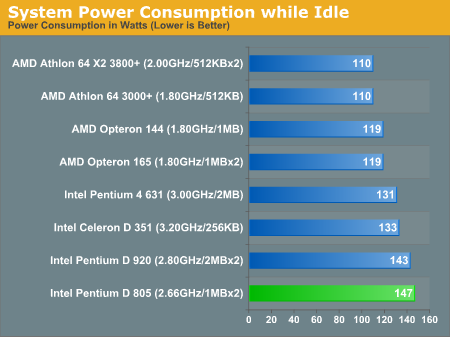
As you can expect, based on the old 90nm Smithfield core, the Pentium D 805 isn't exactly the coolest running chip on the block. In fact, the Athlon 64 3000+ consumes less power under full load than the Pentium D 805 does with both of its cores idling. Note that the higher power consumption on the two Opteron parts is because Cool 'n Quiet would not work with the Opterons on our test platform.

The picture doesn't get any prettier under full load. If you're expecting the Pentium D 805 to be a cool running, quiet chip, you're going to be sorely disappointed. If power consumption matters to you then you're far better off with a Pentium D 900 series or an Athlon 64 X2.
Looking at the long-term prospects, power costs money, so how long will it be before the lower power X2 3800+ reaches the break-even point? If we go with a typical $.10 per kWHr, the X2 3800+ consumes 37W less at idle and 48W less at full load. If that seems like a lot of power initially, it actually only works out to $32-$42 per year, running both systems 24/7. That means you're looking at a minimum of four years to reach equivalence in price+power. What about the 920 versus 805 power costs? The difference there is even less in terms of power use, so even at full load you're looking at $16 per year, or seven years to reach the break-even point.
Of course, you can't just look at power in most instances. The X2 3800+ will offer you faster performance during its lifetime, so it definitely warrants consideration. Lower power, lower heat, lower noise, and higher performance are all nice things to have.
Note: Pentium D 820 numbers were excluded from the power comparison due to technical difficulties with our test platform at the last minute. Based on the data here, you can expect it to consume more power than the Pentium D 805.
Final Words
Note that this article didn't look at the overclocking aspects of the Pentium D 805. We are working on a separate article that will look at exactly what you can expect to extract from the Pentium D 805 in terms of maximum performance should you decide to go with it.
Just as you'd expect, the Pentium D 805 is a very good value if you are either: 1) multitasking, or 2) running multithreaded applications. As we've seen by its performance in Internet Content Creation SYSMark, 3dsmax and our suite of media encoding applications, if you're running the right apps and workloads then the Pentium D 805 offers an unstoppable value. The chip ends up delivering much better overall performance at the price of a single core CPU.
The 805 also does a good job of staying competitive with the Pentium D 820 and 920. In most cases, the 805 offers within 5% of the performance of the Pentium D 820 despite its lower clock speed and 533MHz FSB. For the budget conscious, or if you're planning another more serious upgrade later this year to Socket-AM2 or Conroe, a Pentium D 805 coupled with a cheap 945 motherboard can't be beat.
The fact of the matter is that Socket-AM2 is just around the corner, and Conroe appears to be the Intel chip to wait for, so if you're upgrading or buying today we'd strongly recommend going with a more economical system upgrade. At $133, the Pentium D 805 is a very good balance between price and performance, provided that your workload is multithreaded or multitasking in nature.
Gamers looking for a temporary upgrade should honestly look to the Athlon 64 3000+ instead, as very few games have boarded the dual train as of now.
At the higher end of these value offerings, the Athlon 64 X2 3800+ continues to be a tremendous performer with a relatively low price tag. If you can afford the approximately $300 entry fee, the X2 3800+ will truly impress you across the board. Interestingly enough, we found that for the most part the Opteron 165 just isn't worth it compared to the Athlon 64 X2 3800+. Thanks to AMD's on-die memory controller, the higher clock speed of the 3800+ is more useful than the larger L2 cache of the Opteron 165. (Overclocking makes things a bit more interesting, naturally.)
So there you have it, if you are a multitasker or run multithreaded applications, and you want a great low cost solution, then the Pentium D 805 makes a wonderful stepping stone to a future AM2 or Conroe platform. If you're a gamer that doesn't care about multitasking while gaming, the Athlon 64 3000+ is still a strong value. And finally, if you've got the budget for it, the Athlon 64 X2 3800+ still can't be beat.







